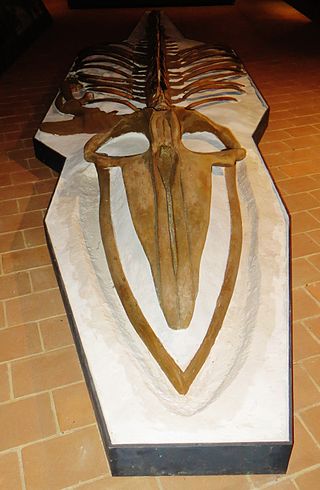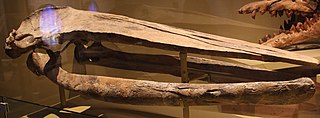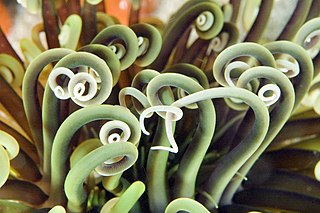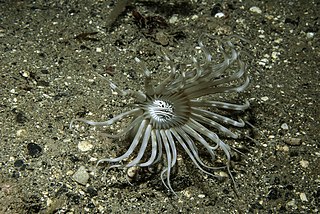
West Maas en Waal is a municipality in the Dutch province of Gelderland.

Édouard Joseph Louis Marie Van Beneden was a Belgian embryologist, cytologist and marine biologist. He was professor of zoology at the University of Liège. He contributed to cytogenetics by his works on the roundworm Ascaris. In this work he discovered how chromosomes organized meiosis.

Tube-dwelling anemones or ceriantharians look very similar to sea anemones but belong to an entirely different class of anthozoans. They are solitary, living buried in soft sediments. Tube anemones live inside and can withdraw into tubes, which are composed of a fibrous material made from secreted mucus and threads of nematocyst-like organelles known as ptychocysts. Within the tubes of these ceriantharians, more than one polyp is present, which is an exceptional trait because species that create tube systems usually contain only one polyp per tube. Ceriantharians were formerly classified in the taxon Ceriantipatharia along with the black corals but have since been moved to their own class, Ceriantharia.

Beneden-Leeuwen is a town in the Dutch province of Gelderland. It is a part of the municipality of West Maas en Waal, and lies about 7 km east of Tiel, on the opposite (southern) bank of the river Waal. Beneden-Leeuwen has 6,925 inhabitants on 1 July 2021. It is the Catholic part of the former village Leeuwen.

Pierre-Joseph van Beneden FRS FRSE FGS FZS was a Belgian zoologist and paleontologist.
Beneden Head is a steep-sided headland, 700 metres (2,300 ft) high, forming the north side of the entrance to Andvord Bay, on the west coast of Graham Land. It was discovered by the Belgian Antarctic Expedition, 1897–99, and named after Professor Edouard Van Beneden, president of the Belgica Commission and author of several of the zoological reports of the expedition.
Mesocetus is an extinct genus of baleen whale from the Miocene of Europe and North America.

Protororqualus is a genus of extinct rorqual from the late Pliocene of Mount Pulgnasco, Italy.

Aglaocetus is a genus of extinct baleen whales known from the Miocene of Patagonia, the US Eastern Seaboard, Japan and the Low Countries. It was once considered a member of Cetotheriidae along with many other putative cetotheres, but was recently recognized as representing a distinct family from true Cetotheriidae.

De Wielewaal is a tower mill in Beneden-Leeuwen, Gelderland, Netherlands which was built in 1857 and is in working order. The mill is listed as a Rijksmonument.

Cerianthidae is a family of tube-dwelling anemones in the order Spirularia of the subclass Ceriantharia.

Arachnactidae is a family of tube-dwelling anemones in the order Ceriantharia. It is the only family in the monotypic order Penicillaria and comprises around 38 species. They differ from other ceriantharians in the makeup of their cnidome, the relative sizes of the oral discs and the shape and structure of the mesenteries. These tube anemones dwell in parchment-like tubes immersed in soft sediment, and have two whorls of tentacles, the outer ones being much longer than the inner ones.
Nanophoca is an extinct genus of earless seals from the middle Miocene of Belgium.
Isodactylactis is a genus of cnidarians belonging to the family Cerianthidae.
Hensenanthula is a genus of cnidarians belonging to the family Botrucnidiferidae.
Calpanthula is a genus of cnidarians belonging to the family Botrucnidiferidae.
Cerianthula is a genus of cnidarians belonging to the family Botrucnidiferidae.
Botrucnidiferidae is a family of cnidarians belonging to the order Spirularia.
Scrupocellaria is a genus of bryozoans belonging to the family Candidae.










